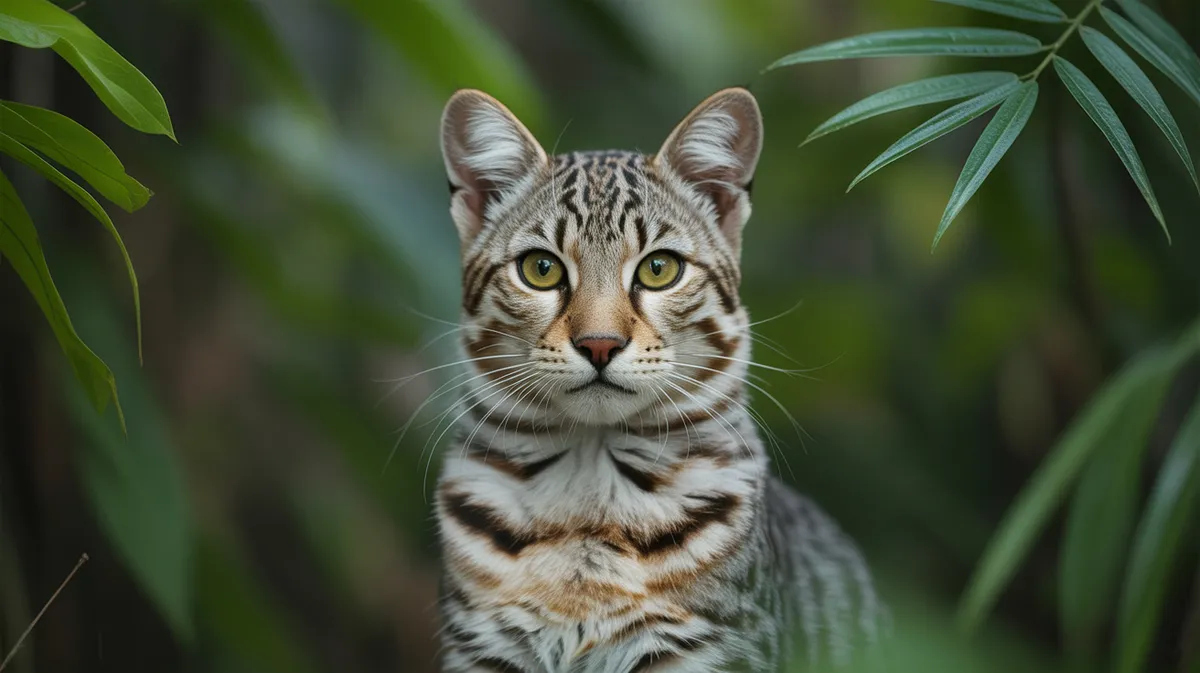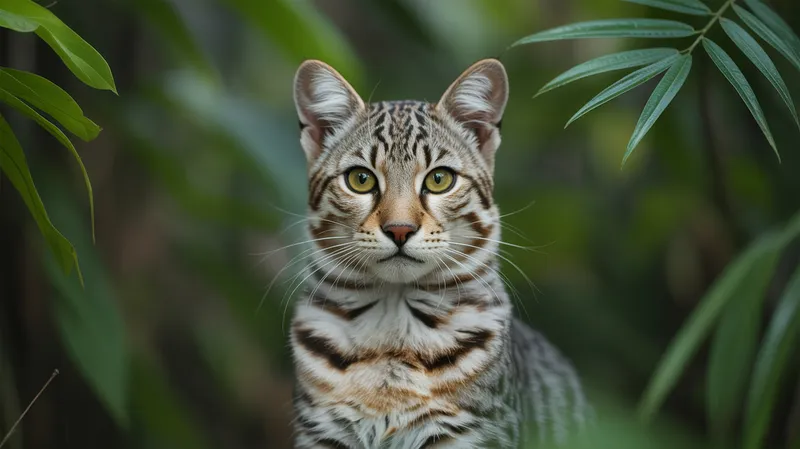
Jungle Curl
Felis catus

Meet the Jungle Curl
The Jungle Curl is a rare and exotic domestic cat breed known for its distinctive curled-back ears and wild, leopard-like spotted coat. Developed by crossing domestic cats with wildcat hybrids, it retains a playful yet intelligent temperament and adapts well to home environments. The breed is admired for its athletic build, expressive eyes, and unique ear shape, setting it apart from other domestic cats. Jungle Curls are sociable, highly interactive, and form strong bonds with their owners, making them a sought-after breed among enthusiasts.
Classification
Mammal
Habitat
Domestic, derived from temperate forests and jungle environments
Diet
Carnivore
Lifespan
12-16 years
Conservation
Not Evaluated
Weight
4–7 kg
📖Fascinating Facts
Curled Ears
Jungle Curls have unique backward-curled ears, a result of a dominant genetic trait that sets them apart from most other cat breeds.
Wild Ancestry
This breed was developed by crossing domestic cats with wildcat hybrids, giving them their distinctive spotted coats and athletic builds.
Affectionate Nature
Despite their exotic look, Jungle Curls are known for their friendly temperament and strong bonds with their human families.
📋Detailed Description
The Jungle Curl is a medium-to-large domestic cat breed, typically weighing between 4.5 and 7.5 kg (10–16.5 lbs), with males generally larger than females. Its most distinguishing anatomical feature is its backward-curled ears, a trait inherited from its wildcat ancestry, which are firm at the base and curve gracefully toward the back of the head. The breed exhibits a muscular, athletic build, with long, powerful limbs and a flexible spine that supports agile movement and impressive jumping ability. The coat is short to medium in length, dense, and marked with bold, leopard-like spots or rosettes on a tawny, golden, or silver background, providing camouflage reminiscent of wild felids. Jungle Curls have large, expressive almond-shaped eyes, often in shades of green, gold, or amber, and a broad, slightly rounded head with prominent whisker pads. Their tails are medium to long, thick at the base, and taper toward the tip, contributing to their wild appearance. Behaviorally, Jungle Curls are highly intelligent, curious, and interactive, displaying a playful energy well into adulthood. They are known for their strong social bonds with humans and other pets, often seeking out companionship and participating in family activities. Their vocalizations are varied and expressive, including chirps, trills, and chatters, reflecting their hybrid heritage.
💡 Did you know?
Despite their wild appearance, Jungle Curls are entirely domestic and have no behavioral traits of their wild ancestors.
🔬Research & Sources
Wikipedia Summary
The following is a list of experimental cat breeds and crossbreeds that do not have the recognition of any major national or international cat registries, such as The International Cat Association (TICA) in the US, Europe, and Australasia; the Governing Council of the Cat Fancy (GCCF) in the UK, the Fédération Internationale Féline (FiFE) in continental Europe, the Cat Fanciers' Association (CFA) in North America, or the more recent World Cat Federation based in Germany. Such a breed may be recognized by one of the smaller cat registries. Smaller registries include the Rare and Exotic Feline Registry (REFR), and others. This list only includes breeds recognized by at least one extant, national or international, multi-breed registry.
Last Modified: 4/14/2025
🎭Behavior & Social Structure
Jungle Curls are active and inquisitive, requiring significant mental and physical stimulation. They are adept climbers and jumpers, frequently exploring vertical spaces and utilizing cat trees or shelves. Their hunting instincts remain strong; they often engage in stalking and pouncing play, and may exhibit a preference for interactive toys that mimic prey movement. Jungle Curls are highly social, forming close-knit relationships with their owners and often following them from room to room. They are generally tolerant of other cats and dogs, provided early socialization occurs. Daily routines include periods of intense activity interspersed with affectionate interactions and rest. Jungle Curls are known for their problem-solving abilities and may learn to open doors or manipulate objects. Their feeding behavior reflects their carnivorous ancestry, with a preference for high-protein diets and occasional interest in raw or freeze-dried treats.
👶Reproduction & Life Cycle
Jungle Curls reach sexual maturity between 8 and 12 months of age. Breeding is typically managed by experienced breeders due to the breed's hybrid origins and the need to maintain genetic health. The mating season is not strictly defined in domestic settings, but queens often exhibit estrus cycles every 2–3 weeks during the breeding season. Gestation lasts approximately 63–66 days, after which litters of 2–5 kittens are born. Kittens are altricial, requiring extensive maternal care, including nursing and grooming. Queens are attentive mothers, and kittens begin to explore their environment at around 3 weeks of age. Weaning occurs between 6 and 8 weeks, and socialization is critical during this period to ensure well-adjusted adults. Responsible breeders prioritize genetic diversity and screen for inherited health conditions.
🛡️Adaptations & Survival
The Jungle Curl's curled ears are a unique adaptation, possibly providing protection to the ear canal and contributing to their distinctive appearance. Their spotted coat offers camouflage, a trait retained from wildcat ancestors, aiding in stealth and hunting behaviors. Muscular bodies and flexible spines allow for agile climbing and leaping, while keen senses of sight and hearing enhance their ability to detect prey or environmental changes. Behaviorally, their intelligence and curiosity are adaptive traits that facilitate problem-solving and environmental enrichment in domestic settings. Social adaptability enables them to thrive in multi-pet households and form strong human-animal bonds.
📚Research Sources
🎨Cultural Significance
The Jungle Curl is primarily valued for its exotic appearance and engaging personality, making it a sought-after companion among enthusiasts of rare and wild-looking cats. While it does not have deep roots in traditional mythology or folklore, its wildcat-like features evoke associations with jungle felids and the allure of the untamed. The breed has occasionally appeared in exotic pet showcases and specialty cat shows, where it is admired for its unique aesthetics. Its development reflects a broader cultural fascination with hybrid and designer animals, blending wild traits with domestic temperament.
🔬Recent Research & Discoveries
Recent research on Jungle Curls focuses on the genetics of ear curling, which is believed to be an autosomal dominant trait similar to that seen in the American Curl. Ongoing studies examine the health implications of hybridization, particularly regarding immune system diversity and susceptibility to inherited disorders. Behavioral studies highlight the breed's intelligence and adaptability, with some research suggesting enhanced problem-solving abilities compared to other domestic breeds. There is interest in the breed's potential as a model for studying domestication and the retention of wild-type traits in domestic cats. The breed's status as an experimental cross means that scientific literature is limited, and most data are derived from breeder records and observational studies.
🎥Wildlife Videos

10 Most Dangerous Cat Breeds You should Know | Aggressive Cat Breeds
10 Most Dangerous Cat Breeds | 10 Most Aggressive Cat Breeds Are all cats cute and cuddly? Maybe not! In this video, we ...
Animal Creature Curiosities

12 Reasons Why You Should Never Own a Chausie! 🚫🐆
Are you thinking of adopting a Chausie? These exotic, wild-looking felines might catch your eye, but owning one is not for ...
Whiskers & Wags

Lion Climb A Tree To Catch Baboon, Herd Baboon Panic Kills Lion Cubs To Revenge - Cheetah vs Impala
Lion Climb A Tree To Catch Baboon, Herd Baboon Panic Kills Lion Cubs To Revenge - Cheetah vs Impala. Welcome to Africa ...
Africa Wild Animals

These 10 CATS Are Worth More Than Your House!
The most expensive cat breeds in the world include Ashera, Persian, and Maine Coon. These beauties, among the top 10 most ...
Full Focus Animals

A wild boar rescued by wildlife officers !
This incident was reported to the wildlife officers by the villagers.A team of wildlife officers visited the place where the wild boar ...
cp wild Lanka
🌍Habitat Information
The Jungle Curl typically inhabits Domestic, derived from temperate forests and jungle environments environments. Jungle Curls have adapted to their environments with specialized features and behaviors.
Primary Habitat:
Domestic, derived from temperate forests and jungle environments
More detailed habitat information will be available soon.
🛡️Conservation Status
The Jungle Curl is currently classified as Not Evaluated. Conservation efforts are crucial for preserving this species for future generations.
Common Threats:
- 🏠Habitat loss and fragmentation
- 🌡️Climate change impacts
- 🎯Hunting and poaching
- 🏭Human-wildlife conflict
⚠️Threats & Conservation Challenges
As an experimental breed, Jungle Curls face challenges related to genetic diversity and potential inbreeding, which can increase susceptibility to hereditary diseases. Lack of recognition by major cat registries limits standardized breeding programs and access to broader genetic pools. There are no known wild populations; all individuals are captive-bred. Human impact is primarily through selective breeding and the exotic pet trade, which can sometimes incentivize irresponsible breeding practices. Population trends are difficult to assess due to the breed's rarity and lack of centralized registry data. Conservation status is currently 'Not Evaluated' by the IUCN, but responsible breeding and education are essential to maintain breed health and welfare.
🔬Scientific Classification
Scientific Name
Felis catus
Classification Hierarchy
🔍 About Taxonomic Classification
Taxonomic classification is a hierarchical system used by scientists to classify and organize living organisms based on shared characteristics and evolutionary relationships.
The system moves from broad categories (Kingdom) to increasingly specific ones, with each animal's scientific name typically consisting of its Genus and species.
📝Community Notes
Share your observations and insights about the Jungle Curl with our community of wildlife enthusiasts.
Join Our Community
Sign in to share your observations and connect with fellow wildlife enthusiasts.
Sign In to ContributeNo community notes yet
Be the first to share your observations about the Jungle Curl!
Explore Jungle Curl
Select a tab above to learn more about this amazing animal.
📸Photo Gallery
No photos available for this animal yet.
🌟Discover More Wildlife
Continue your journey of discovery with more fascinating animals from our database
